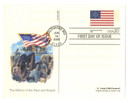
Battle of Fort Sumter Begins Civil War
On April 12, 1861, North and South clashed for the first time at Fort Sumter, South Carolina. It was the opening battle of the Civil War, the bloodiest conflict in American history.
The day after Christmas, rowboats sliced quietly across Charleston Harbor under cover of darkness. South Carolina had seceded six days earlier, leaving Union Major General Robert Anderson and his group of 127 men stranded at Fort Moultrie, deep within rebel territory. Anderson and his troops left Fort Moultrie, which was impossible to defend, for the daring journey to nearby Fort Sumter, which was one of the strongest garrisons in the world at the time. As the sun rose, Anderson’s men proudly hoisted the Stars and Stripes over Fort Sumter, where it waved above the entrance to South Carolina’s most important port city.
South Carolina Governor Francis W. Pickens was outraged. President Buchanan had promised him Fort Sumter would remain unoccupied, yet the merchant ship Star of the West was sent to Fort Sumter to supply Anderson with food, small arms, and 200 men. Fearing this was the assault they’d expected since secession, rebels rushed to Charleston by the thousands to man shore batteries and fire at the ship. Hoping to prevent war, Major Anderson decided against using Sumter’s artillery to protect the Star of the West.
South Carolina seized all federal property in Charleston (including Fort Moultrie) except Fort Sumter. General Pierre G. T. Beauregard, who had studied under Major Anderson at West Point, was sent to fortify the area around Charleston Harbor for battle. Beauregard surrounded Fort Sumter with a force of about 6,000 troops and 19 batteries.
In the weeks to come, the Confederate States of America was formed, Abraham Lincoln was inaugurated, and both sides tried to shore up critical alliances with Great Britain and France. As the march to civil war quickened, all eyes were upon Fort Sumter.
On April 6, President Lincoln notified Pickens he would supply only food to the troops at Fort Sumter. If the Confederates didn’t interfere, the federal government would not deliver men, arms, or ammunition.
Having hostile troops in control of Charleston Harbor was a serious threat to the Confederacy, which made their removal a top priority. Confederate President Jefferson Davis ordered Beauregard to demand the surrender Fort Sumter and destroy the facility if any supplies were brought to the Union soldiers.
Waving a white flag, Confederates Stephen D. Lee and James Chestnut Jr. rowed across Charleston Harbor to deliver the ultimatum on the afternoon of April 11, 1861. Anderson refused. “I shall wait for the first shot, and if you do not batter us to pieces, we shall be starved out in a few days.â€
Beauregard was instructed to withhold fire if Anderson would set a date for evacuation. If not, he was told to “reduce the fort as your judgment decides to be most practicable.†In the early morning hours of April 12, Lee and Chestnut were sent across the harbor again to present Anderson with a way to avoid bloodshed.
Anderson agreed to evacuate by noon on the 15th unless new orders or supplies were received, but didn’t pledge to withhold fire. This was exactly what Beauregard had been ordered to prevent. Anderson was told shots would be fired in one hour. He shook hands with the Confederate messengers, saying, “If we never meet in this world again, God grant that we may meet in the next.â€
A single shot was fired at Fort Sumter at 4:30 a.m., followed by more at two-minute intervals. Union ships bearing supplies lay nearby, but were held at bay by the artillery. Beauregard’s forces heated cannon balls and fired them deliberately into wooden buildings on Fort Sumter. The fort became an inferno, threatening to explode the facility’s stores of gunpowder. At noon the following day, a Charleston newspaper reported the “entire roof of the barracks at Fort Sumter are in a vast sheet of flame. Shells from Cummings’ Point and Fort Moultrie are bursting in and over Fort Sumter in quick succession. The Federal flag still waves. Major Anderson is only occupied in putting out the fire. Every shot on Fort Sumter now seems to tell heavily.â€
Aside from being short on supplies, Anderson’s troops were also stymied by the original design of Fort Sumter. Built in the aftermath of the War of 1812 to defend against a naval attack, Sumter’s guns pointed outward toward the sea rather than inland. Starved, outmanned and outgunned, the men of Fort Sumter agreed to a truce and lowered the United States flag at 2 p.m. on April 13th.
Lincoln immediately called for 75,000 troops to preserve the Union, rallying Northerners and prompting four additional states to secede. Charleston Harbor remained in Confederate hands for the rest of the war, leaving a gap in the Union blockade. The Civil War had begun.














